Heat & Glo LifeStyle 6000XLT-CDN, 6000TR, 6000 ARCH, 6000 XLS User Manual
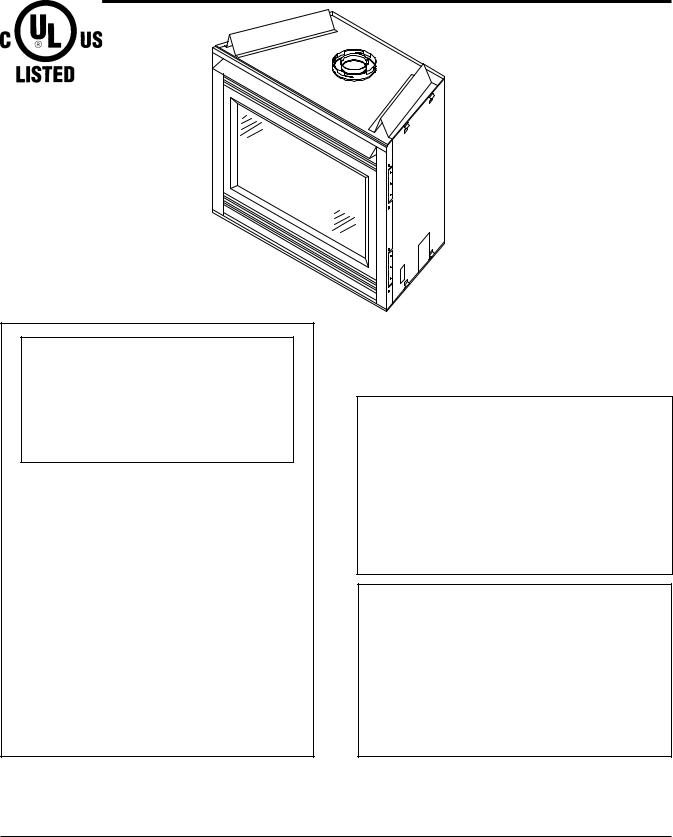
Heat-N-Glo
Models:
6000TR 6000XLT-CDN 6000ARCH 6000XLS
Installers Guide
Underwriters
Laboratories Listed
WARNING: IF THE INFORMATION IN THESE INSTRUCTIONS IS NOT FOLLOWED EXACTLY, A FIRE OR EXPLOSION MAY RESULT CAUSING PROPERTY DAMAGE, PERSONAL INJURY, OR DEATH.
-Do not store or use gasoline or other flammable vapors and liquids in the vicinity of this or any other appliance.
-What to do if you smell gas
•Do not try to light any appliance.
•Do not touch any electrical switch.
•Do not use any phone in your building.
•Immediately call your gas supplier from a neighbor's phone. Follow the gas supplier's instructions.
•If you cannot reach your gas supplier, call the fire department.
-Installation and service must be performed by a qualified installer, service agency, or the gas supplier.
Printed in U.S.A. Copyright 2000,
Heat-N-Glo, a division of Hearth Technologies Inc. 20802 Kensington Boulevard, Lakeville, Mn 55044
READ THIS MANUAL BEFORE INSTALLING OR OPERATING THIS APPLIANCE. THIS INSTALLERS GUIDE MUST BE LEFT WITH THE APPLIANCE FOR FUTURE REFERENCE.
WARNING: IMPROPER INSTALLATION, ADJUSTMENT, ALTERATION, SERVICE OR MAINTENANCE CAN CAUSE INJURY OR PROPERTY DAMAGE. REFER TO THIS MANUAL. FOR ASSISTANCE OR ADDITIONAL INFORMATION CONSULT A QUALIFIED INSTALLER, SERVICE AGENCY, OR THE GAS SUPPLIER.
1.This appliance may be installed in an aftermarket, permanently located, manufactured (mobile) home, where not prohibited by local codes.
2.This appliance is only for use with the type of gas indicated on the rating plate. This appliance is not convertible for use with other gases, unless a certified kit is used.
Please contact your Heat-N-Glo dealer for any questions or concerns. For the number of your nearest Heat-N-Glo dealer, please call 612-985-6000.
This product is covered by one or more of the following patents: (United States) 4,112,913; 4,408,594; 4,422,426; 4,424,792;1 4,520,791; 4,793,322; 4,852,548; 4,875,464; 5,000,162; 5,016,609; 5,076,254 5,191,877; 5,218,953; 5,328,356; 5,429,495; 5,452,708; 5,542,407; 5,613,487; (Australia) 543790; 586383; (Canada) 1,123,296; 1,297,746; 2,195,264; (Mexico) 97-0457; (New Zealand) 200265; or other U.S. and foreign patents pending.
525-983C 1/00
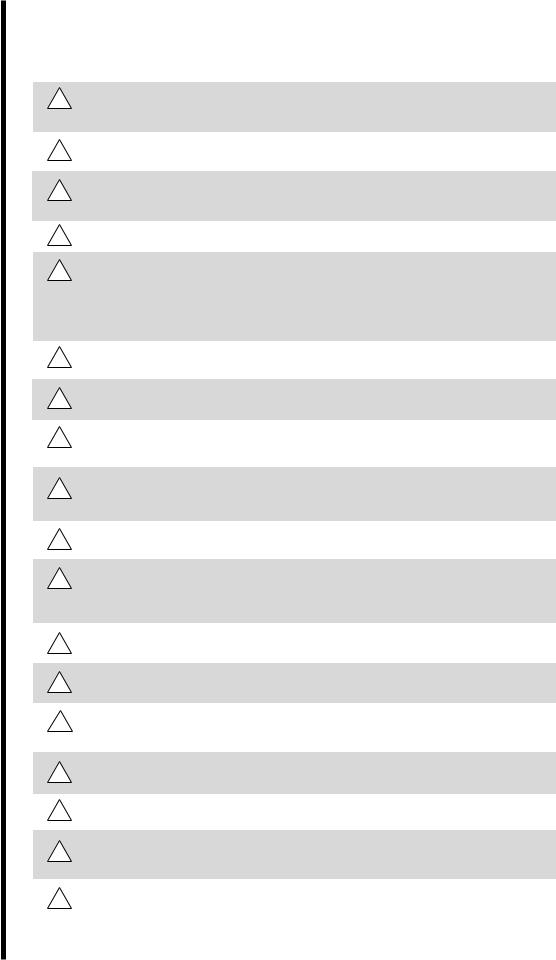
SAFETY AND WARNING INFORMATION
!READ and UNDERSTAND all instructions carefully before starting the installation. FAILURE TO FOLLOW these installation instructions may result in a possible fire hazard and will void the warranty.
Prior to the first firing of the fireplace, READ the Using Your Fireplace section of the
!Owners Guide.
DO NOT USE this appliance if any part has been under water. Immediately CALL a
!qualified service technician to inspect the unit and to replace any part of the control system and any gas control which has been under water.
!THIS UNIT IS NOT FOR USE WITH SOLID FUEL.
Installation and repair should be PERFORMED by a qualified service person. The
!appliance and venting system should be INSPECTED before initial use and at least annually by a professional service person. More frequent cleaning may be required due to excessive lint from carpeting, bedding material, etc. It is IMPERATIVE that the unit’s control compartment, burners, and circulating air passageways BE KEPT CLEAN to provide for adequate combustion and ventilation air.
!Always KEEP the appliance clear and free from combustible materials, gasoline, and other flammable vapors and liquids.
NEVER OBSTRUCT the flow of combustion and ventilation air. Keep the front of the
!appliance CLEAR of all obstacles and materials for servicing and proper operations. Due to the high temperature, the appliance should be LOCATED out of traffic areas
!and away from furniture and draperies. Clothing or flammable material SHOULD NOT BE PLACED on or near the appliance.
Children and adults should be ALERTED to the hazards of high surface temperature
!and should STAY AWAY to avoid burns or clothing ignition. Young children should be CAREFULLY SUPERVISED when they are in the same room as the appliance.
!These units MUST use one of the vent systems described in the Installing the Fireplace section of the Installers Guide. NO OTHER vent systems or components MAY BE USED.
!This gas fireplace and vent assembly MUST be vented directly to the outside and MUST NEVER be attached to a chimney serving a separate solid fuel burning appliance. Each gas appliance MUST USE a separate vent system. Common vent systems are PROHIBITED.
!INSPECT the external vent cap on a regular basis to make sure that no debris is interfering with the air flow.
!The glass door assembly MUST be in place and sealed, and the trim door assembly MUST be in place on the fireplace before the unit can be placed into safe operation.
DO NOT OPERATE this appliance with the glass door removed, cracked, or broken.
!Replacement of the glass door should be performed by a licensed or qualified service person. DO NOT strike or slam the glass door.
!The glass door assembly SHALL ONLY be replaced as a complete unit, as supplied by the gas fireplace manufacturer. NO SUBSTITUTE material may be used.
!DO NOT USE abrasive cleaners on the glass door assembly. DO NOT ATTEMPT to clean the glass door when it is hot.
Turn off the gas before servicing this appliance. It is recommended that a qualified
!service technician perform an appliance check-up at the beginning of each heating season.
Any safety screen or guard removed for servicing must be replaced before operating
!this appliance.
2

Safety and Warning Information ......................... |
2 |
|
Section 1: Approvals and Codes ...................... |
4 |
|
Approval Listings and Codes ................................... |
4 |
|
Appliance Certification ............................................. |
4 |
|
Installation Codes .................................................... |
4 |
|
HighAltitude Installations.......................................... |
4 |
|
Section 2: Getting Started ................................ |
5 |
|
Introducing the Heat-N-Glo Gas Fireplaces .............. |
5 |
|
Pre-installation Preparation...................................... |
5 |
|
Section 3: Installing the Fireplace .................... |
8 |
|
Step 1 |
Locating the Fireplace ............................... |
8 |
Step 2 |
Framing the Fireplace ............................... |
9 |
Step 3 |
Installing the Vent System ........................ |
10 |
|
A. Vent System Approvals ........................ |
10 |
|
B. Installing Vent Components ................. |
20 |
|
C. Vent Termination ................................. |
26 |
Step 4 |
Positioning, Leveling, and |
|
|
Securing the Fireplace ............................. |
31 |
Step 5 |
The Gas Control Systems ....................... |
31 |
Step 6 |
The Gas Supply Line ............................... |
32 |
Step 7 |
Gas Pressure Requirements ................... |
33 |
Step 8 |
Wiring the Fireplace ................................ |
34 |
Step 9 |
Finishing ................................................. |
36 |
Step 10 |
Installing Trim, Logs, and |
|
|
Ember Material ........................................ |
37 |
|
Installing the Trim..................................... |
37 |
|
Positioning the Logs ................................ |
38 |
|
Placing the Ember Material ...................... |
38 |
Step 11 Before Lighting the Fireplace.................... |
40 |
|
Step 12 Lighting the Fireplace ............................... |
40 |
|
Step 13 Heating Control - 6000XLT-CDN .............. |
41 |
|
Step 14 |
Relief Ports - 6000ARCH ......................... |
41 |
After the Installation ............................................... |
41 |
|
Section 4: Maintenance and Servicing .......... |
42 |
|
Section 5: Replacement Parts |
|
|
and Accessories ................................................. |
44 |
|
Replacement Parts ............................................... |
44 |
|
Accessories ......................................................... |
48 |
|
TABLE
OF
CONTENTS
3

1
Approvals
and Codes
4
Approval Listings |
Appliance Certification |
|||
and Codes |
The Heat-N-Glo models discussed in this Installers |
|||
|
|
Guide have been tested to certification standards |
||
|
|
and listed by the applicable laboratories. |
||
|
|
|
|
|
|
|
|
|
CERTIFICATION |
MODEL |
LABORATORY |
TYPE |
STANDARD |
|
6000TR & |
Underwriters |
|
Vented Gas |
ANSI Z21.50• CGA2.22/IR#41 |
6000ARCH |
Laboratories |
|
Fireplace |
|
6000XLT-CDN |
Underwriters |
|
Vented Gas Fireplace |
ANSI Z21.50• CGA2.22 |
|
Laboratories |
|
& Vented Gas |
ANSI Z21.88• CSA2.33 |
|
|
|
Fireplace Heater |
|
|
|
|
|
|
6000XLS |
Underwriters |
|
Vented Gas |
ANSI Z21.88• CSA2.33 |
|
|
|
Fireplace Heater |
|
|
|
|
|
|
Installation Codes
The fireplace installation must conform to local codes. Before installing the fireplace, consult the local building code agency to ensure that you are in compliance with all applicable codes, including permits and inspections.
In the absence of local codes, the fireplace installation must conform to the National Fuel Gas Code ANSI Z223.1 (in the United States) or the CAN/CGAB149 Installation Codes (in Canada). The appliance must be electrically grounded in accordance with local codes or, in the absence of local codes with the National Electric Code ANSI/NFPA No. 70 (in the United States), or to the CSA C22.1 Canadian Electric Code (in Canada).
These models may be installed in a bedroom or bed-sitting room in the U.S.A. and Canada.
High Altitude Installations
U.L. Listed gas fireplaces are tested and approved for elevations from 0 to 2,000 feet in the U.S.A. and from 0 to 4,500 feet in Canada.
When installing this fireplace at an elevation above 2,000 feet (in the United States), it may be necessary to decrease the input rating by changing the existing burner orifice to a smaller size. Input should be reduced four percent (4%) for each 1,000 feet above sea level, unless the heating value of the gas has been reduced, in which case this general rule will not apply. To identify the proper orifice size, check with the local gas utility.
When installing this fireplace at an elevation between 2,000 and 4,500 feet (in Canada), the input rating must be reduced by ten percent (10%).
When installing this fireplace at an elevation above 4,500 feet (in Canada), check with local authorities.
Consult your local gas utility for assistance in determining the proper orifice for your location.

Introducing the
Heat-N-Glo
Gas Fireplaces
Pre-install
Preparation
Heat-N-Glo direct vent gas fireplaces are designed to operate with all combustion air siphoned from outside of the building and all exhaust gases expelled to the outside.
The information contained in this Installers Guide, unless noted otherwise, applies to all models and gas control systems.
Gas fireplace diagrams, including the dimensions, are shown in this section.
This gas fireplace and its components are tested and safe when installed in accordance with this Installers Guide. Report to your dealer any parts damaged in shipment, particularly the condition of the glass. Do not install any unit with damaged, incomplete, or substitute parts.
NOTE: FOR MODEL 6000TR ONLY:
These fireplaces are shipped from the factory with a BTU rating of 27,000 BTU’s. The fireplace can be installed with the vent pipe coming off the top of the unit or the rear of the unit. If you install the unit with the vent pipe coming off the top of the unit, you may run the unit at 31,000 BTU (NG) (30,000 BTU LP), replace the burner orifice with the orifice included in the manual bag. DO NOT REPLACE THE ORIFICE
IF YOU ARE USING THE REAR SET OF VENT COLLARS.
Changing the orifice when venting out the top.
1.Remove the glass door.
2.Using a 1/4” socket, remove the sheetmetal screws holding the long refractory clip in place. Remove the logs and refractory as one piece.
3.Remove the protective plastic from the logs.
4.Remove the two sheetmetal screws holding the burner and remove the burner.
5.Replace the burner orifice with the orifice included in the plastic manual bag (#36DMS for natural gas or #51DMS for propane). Be careful to hold the brass elbow so you don’t kink the aluminum tube.
6.Reverse the steps to replace the burner, logs, refractory, and clip.
The vent system components and trim doors are shipped in separate packages. The gas logs may be packaged separately and must be field installed.
Read all of the instructions before starting the installation. Follow these instructions carefully during the installation to ensure maximum safety and benefit. Failure to follow these instructions will void the owner’s warranty and
may present a fire hazard.
2
Getting
Started
5
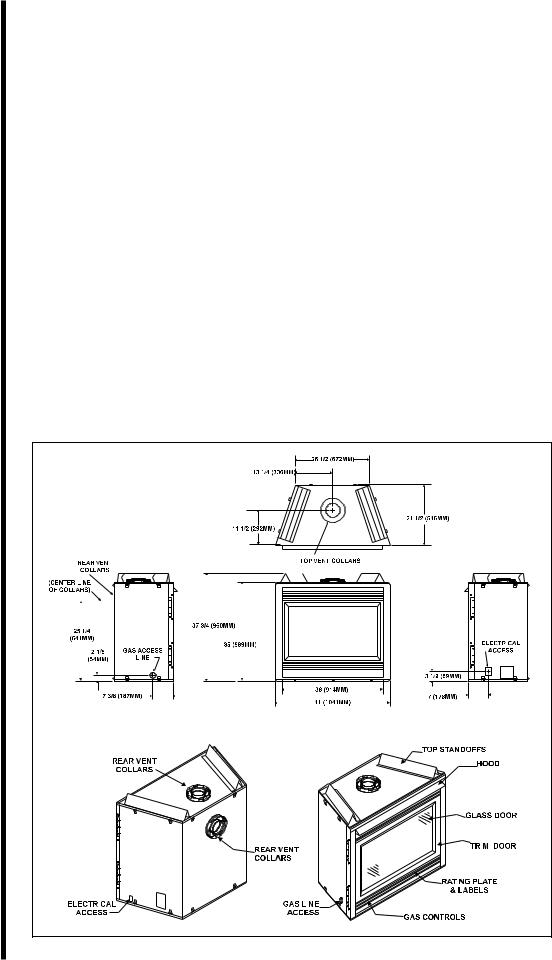
The Heat-N-Glo Warranty will be voided by, and Heat-N-Glo disclaims any responsibility for, the following actions:
•Installation of any damaged fireplace or vent system component.
•Modification of the fireplace or direct vent system.
•Installation other than as instructed by Heat-N-Glo.
•Improper positioning of the gas logs or the glass door.
•Installation and/or use of any component part not manufactured and approved by Heat-N-Glo, not withstanding any independent testing laboratory or other party approval of such component part or accessory.
ANY SUCH ACTION MAY POSSIBLY CAUSE A FIRE HAZARD.
When planning a fireplace installation, it’s necessary to determine:
•Where the unit is to be installed.
•The vent system configuration to be used.
•Gas supply piping.
•Electrical wiring.
•Framing and finishing details.
•Whether optional accessories—devices such as a fan, wall switch, or remote control—are desired.
If the fireplace is to be installed on carpeting or tile, or on any combustible material other than wood flooring, the fireplace should be installed on a metal or wood panel that extends the full width and depth of the fireplace.
NOTE:
6000TR has top and rear collars. 6000XLT-CDN has top collars only. 6000XLS has rear collars only.
|
|
|
|
|
|
|
|
|
|
|
|
|
|
|
|
|
|
|
|
|
|
|
|
|
|
|
|
|
|
|
|
|
|
|
|
|
|
|
|
|
|
|
|
|
|
|
|
|
|
|
|
|
|
|
|
|
|
|
|
|
|
|
|
|
|
|
|
|
|
|
|
|
|
|
|
|
|
|
|
|
|
|
|
|
|
|
|
|
|
|
|
|
|
|
|
|
|
|
|
|
|
|
|
|
|
|
|
|
|
|
|
|
|
|
|
|
|
|
|
|
|
|
|
|
|
|
|
|
|
|
|
|
|
|
|
|
|
|
|
|
|
|
|
|
|
|
|
|
|
|
|
|
|
|
|
|
|
|
|
|
|
|
|
|
|
|
|
|
|
|
|
|
|
|
|
|
|
|
|
|
|
|
|
|
|
|
|
|
|
|
|
|
|
|
|
|
|
|
|
|
|
|
|
|
|
|
|
|
|
|
|
|
|
|
|
|
|
|
|
|
|
|
|
|
|
|
|
|
|
|
|
|
|
|
|
|
|
|
|
|
|
|
|
|
|
|
|
|
|
|
|
|
|
|
|
|
|
|
|
|
|
|
|
|
|
|
|
|
|
|
|
|
|
|
|
|
|
|
|
|
|
|
|
|
|
|
|
|
|
|
|
|
|
|
|
|
|
|
|
|
|
|
|
|
|
|
|
|
|
|
|
|
|
|
|
|
|
|
|
|
|
|
|
|
|
|
|
|
|
|
|
|
|
|
|
|
|
|
|
|
|
|
|
|
|
|
|
|
|
|
|
|
|
|
|
|
|
|
|
|
|
|
|
|
|
|
|
|
|
|
|
|
|
|
|
|
|
|
|
|
|
|
|
|
|
|
|
|
|
|
|
|
|
|
|
|
|
|
|
|
|
|
|
|
|
|
|
|
|
|
|
|
|
|
|
|
|
|
|
|
|
|
|
|
|
|
|
|
|
|
|
Left Side |
|
|
|
|
|
|
|
|
Front |
Right Side |
|
|||||||||||||||
|
|
|
|
|
|
|
|
|
|
|
|
|
|
|
|
|
|
|
|
|
|
|
|
|
|
|
|
|
|
|
|
|
|
|
|
|
|
|
|
|
|
|
|
|
|
|
|
|
|
|
|
|
|
|
|
|
|
|
|
|
|
|
|
|
|
|
|
|
|
|
|
|
|
|
|
|
|
|
|
|
|
|
|
|
|
|
|
|
|
|
|
|
|
|
|
|
|
|
|
|
|
|
|
|
|
|
|
|
|
|
|
|
|
|
|
|
|
|
|
|
|
|
|
|
|
|
|
|
|
|
|
|
|
|
|
|
|
|
|
|
|
|
|
|
|
|
|
|
|
|
|
|
|
|
|
|
|
|
|
|
|
6
Figure 1. Diagram of the 6000TR, 6000XLT-CDN and 6000XLS
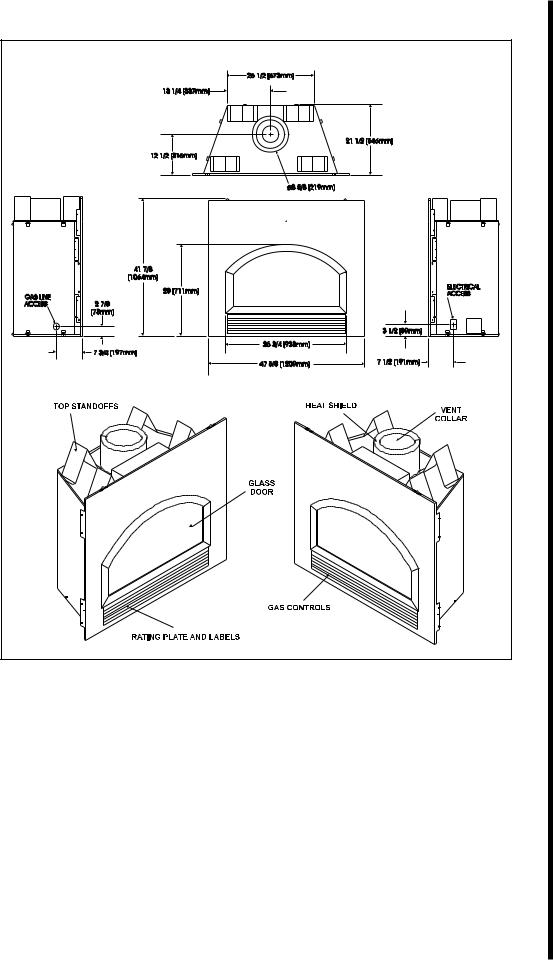
Figure 2. Diagram of the 6000ARCH
7
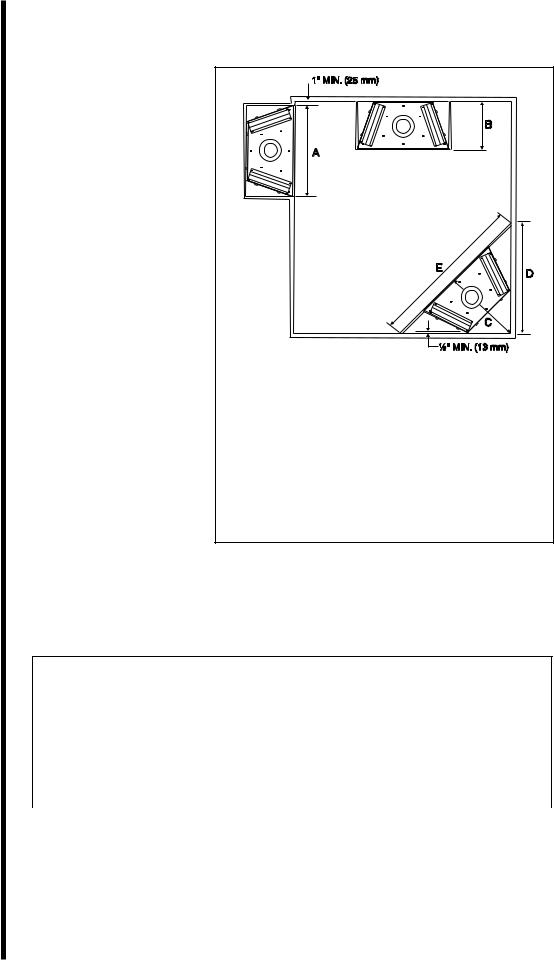
3
Installing the
Fireplace
8
Step 1
Locating the
Fireplace
The diagram below shows space and clearance requirements for locating a fireplace within a room.
MODEL |
A |
B |
C |
D |
E |
|
6000TR & |
42 |
22 |
37 1/8 |
52 1/2 |
74 1/4 |
|
6000XLS |
||||||
|
|
|
|
|
||
6000XLT-CDN |
42 |
22 |
35 1/4 |
49 3/4 |
70 3/8 |
|
6000ARCH |
42* |
22 |
35 1/4 |
49 3/4 |
70 3/8 |
481/4**
* SURROUND IN FRONT OF FINISHED WALL
**SURROUND FLUSH WITH FINISHED WALL. NOTE: DIMENSIONS SHOWN IN INCHES.
Figure 3. Fireplace Dimensions, Locations, and
Space Requirements
Clearance Requirements
The top, back, and sides of the fireplace are defined by stand-offs.
Minimum Clearances from the Fireplace to
Combustible Materials
Glass |
|
Rear of |
Sides of |
Top of |
|
Front |
Floor |
Fireplace |
Fireplace |
Fireplace |
Ceiling |
|
|
|
|
|
|
36 inches |
0 |
1/2 inch |
1/2 inch |
3-1/2 inches |
31 inches |
(914 mm) |
|
(13 mm) |
(13 mm) |
(89 mm) |
(787 mm) |
|
|
|
|
|
|
The minimum clearance to a perpendicular wall extending past the face of the fireplace is one inch (25 mm).
The back of the fireplace may be recessed 21 1/2 inches (546 mm) into combustible construction.
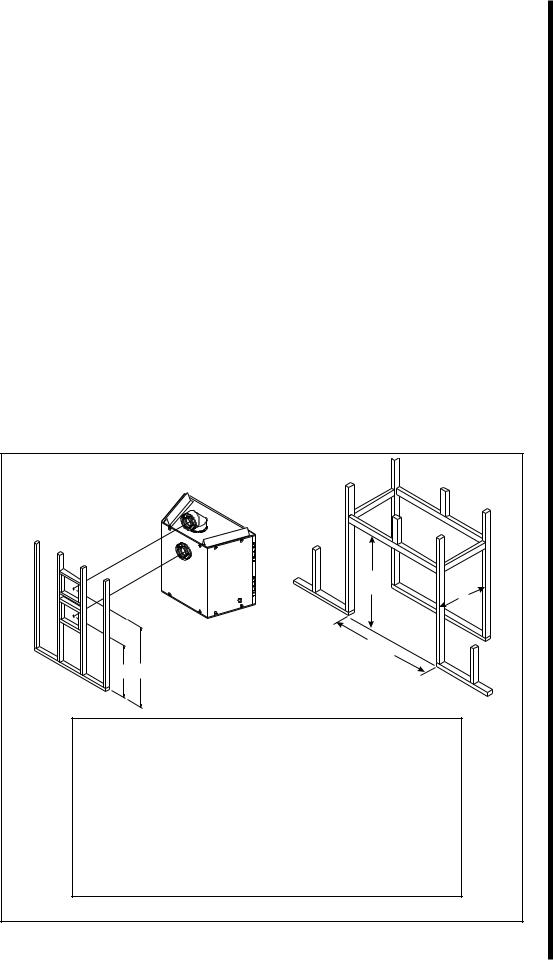
|
|
Minimum Clearances from the Vent Pipe to |
|
|
|||||
|
|
|
Combustible Materials |
|
|
|
|||
|
|
|
|
|
|
|
|
|
|
|
|
|
|
For Vertical |
|
|
|
|
|
For Horizontal Sections |
Sections |
At Wall Firestops |
|||||||
|
|
|
|
|
|
|
|
|
|
Top |
|
Bottom |
Sides |
|
Top |
Bottom |
Sides |
||
|
|
|
|
|
|
|
|
|
|
3 inches |
|
1 inch |
1 inch |
1 inch |
2-1/2 inches |
1/2 inch |
1 inch |
||
(75 mm) |
|
(25 mm) |
(25 mm) |
(25 mm) |
(63.7 mm) |
(13 mm) |
(25 mm) |
||
|
|
|
|
|
|
|
|
|
|
|
|
|
For minimum clearances, see the direct vent |
||||||
|
|
|
termination clearance diagrams on pages 28 and 30 in |
||||||
|
|
|
this manual. |
|
|
|
|
||
Step 2 |
|
Fireplace framing can be built before or after the |
|||||||
Framing the |
fireplace is set in place. Framing should be positioned |
||||||||
Fireplace |
to accommodate wall coverings and fireplace facing |
||||||||
material. The diagram below shows framing reference |
|||||||||
|
|
|
|||||||
|
|
|
dimensions. |
|
|
|
|
||
CAUTION |
|
MEASURE FIREPLACE DIMENSIONS, AND |
|||||||
|
|
|
VERIFY FRAMING METHODS AND WALL |
||||||
|
|
|
COVERING DETAILS, BEFORE FRAMING |
||||||
|
|
|
CONSTRUCTION BEGINS. |
|
|
|
|||
SHOWS CENTER OF12" X 12"
VENT FRAMING HOLES FOR
TOP & REAR VENTING.
|
|
|
|
B |
|
|
|
|
|
|
C |
|
|
Framing should be |
A |
|
|
|
|
|
|
||
E D |
|
constructed of 2 X 4 |
|
|
|
|
|
lumber or heavier. |
|
|
|
Model |
A |
B |
C |
D |
E |
6000TR |
42 |
38 1/4 |
22 |
42 |
26 1/4 |
6000XLS |
42 |
38 1/4 |
22 |
N/A |
26 1/4 |
6000XLT-CDN |
42 |
38 1/4 |
22 |
42 |
N/A |
6000ARCH |
42* |
41 7/8 |
22 |
53 5/8 |
N/A |
|
48 1/4** |
|
|
|
|
* SURROUND IN FRONT OF FINISHED WALL |
|
|
|
||
** SURROUND FLUSH WITH FINISHED WALL |
|
|
|
||
NOTE: DIMENSIONS SHOWN IN INCHES |
|
|
|
||
Figure 4. Framing Dimensions |
|
|
|
9 |
|
|
|
|
|
||
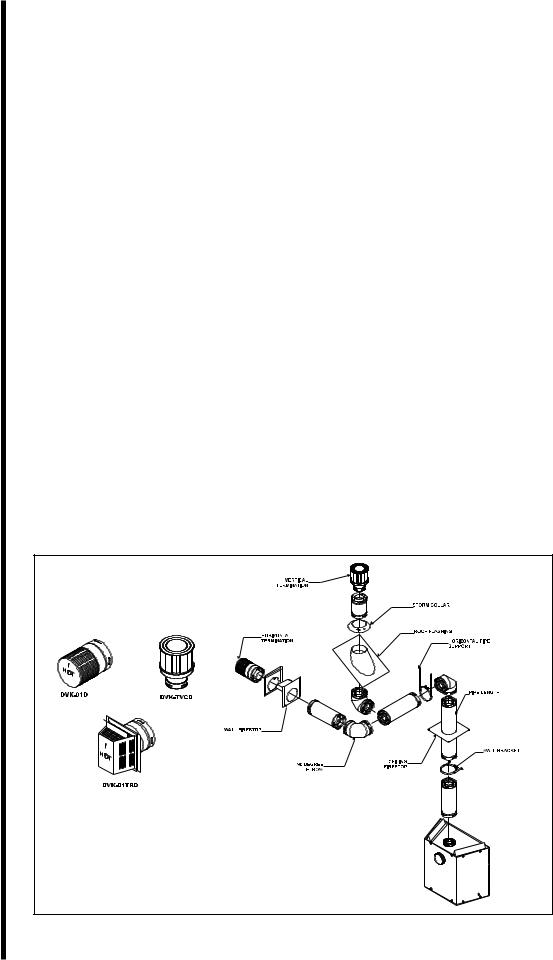
|
Step 3 |
A. Vent System Approvals |
|
Installing the |
These models are approved to use D-series direct vent |
|
Vent System |
pipe components and terminations. Approved vent |
|
|
system components are labeled for identification. NO |
|
|
OTHER VENTING SYSTEMS OR COMPONENTS |
|
|
MAY BE USED. Detailed installation instructions are |
|
|
included with each vent termination kit and should be |
|
|
used in conjunction with this Installers Guide. The |
|
|
drawing below shows vent system components and |
|
|
terminations. |
|
|
The flame and ember appearance may vary based on the |
|
|
type of fuel burned and the venting configuration used. |
|
|
Identifying Vent Components |
|
|
The vent systems installed on this gas fireplace may |
|
|
include one, two, or three 90° elbow assemblies. The |
|
|
relationships of vertical rise to horizontal run in vent |
|
|
configurations using 90° elbows MUST BE strictly |
|
|
adhered to. The rise to run relationships are shown in |
|
|
the venting drawings and tables. Refer to the diagrams |
|
|
on the next several pages. |
|
|
NOTE: TWO 45° ELBOWS MAY BE USED IN PLACE |
|
|
OF ONE 90° ELBOW. RISE TO RUN RATIOS IN THE |
|
|
VENT SYSTEM MUST BE FOLLOWED IF 45° |
|
|
ELBOWS ARE USED. |
|
|
This model has vent starting collars on both the top and |
|
|
the back of the unit. Depending upon the installation, |
|
|
decide which ONE set of starting collars will be used to |
|
|
attach the vent system. The starting collar sealing cap |
|
|
must remain on the starting collar NOT used. |
|
|
VENT SYSTEM COMPONENTS |
|
VENT SYSTEM |
|
|
TERMINATION KITS |
|
10 |
Figure 5. Vent Components and Terminations |
|
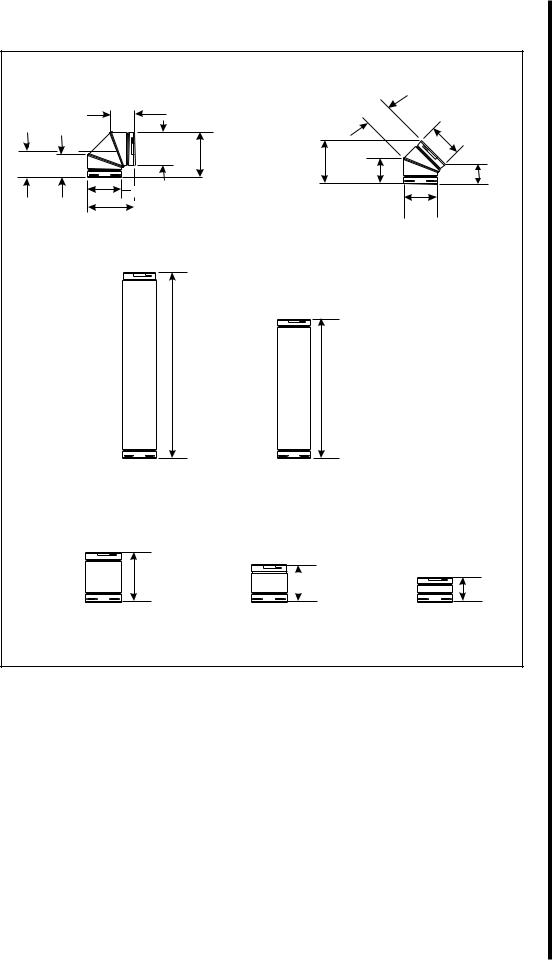
DV-45D
7
|
DV-90D |
|
|
|
|
6-7/16" |
|
|
|
||
|
6-5/32" |
|
|
|
|
|
|
|
|
|
|
|
|
|
|
|
|
|
7/16 |
|
|
||
|
(156 mm) |
|
|
|
|
|
|
(164 mm) |
|
|
|
|
5/32 |
|
|
|
|
|
|
|
|
|
|
|
|
|
|
|
|
|
|
|
|
881/2-1/2" |
|
|
|
|
|
|
|
|
|
|
|
(216 mm) |
|
|
|
|
8-1/2" |
|
|
|
|
|
|
|
|
|
|
|
8 |
/12 |
11-5/8" |
11-1/16" |
|
|
|
|
|
|
|
|
(216 mm) |
11 5/8 |
|
|
|
|
|||
7-3/8" 5-7/8" |
|
|
|
(295 mm) |
11 |
1/16 |
|
|
|
|
|
|
|
|
(281 mm) |
6-1/2" |
|
|
|
||||
3/8 |
5 7/8 |
|
|
|
|
|
5-1/16" |
||||
(187 mm) (149 mm) |
|
|
|
|
|
|
6 1/2 |
|
|||
|
|
|
|
|
|
|
|
(165 mm) |
5 |
1/16 |
|
|
8-5/8" |
|
|
|
|
(129 mm) |
|||||
|
|
|
|
|
|
|
|||||
|
8 |
5/8 |
|
|
|
|
|
|
|
|
|
|
(220 mm) |
|
|
|
|
|
|
|
|||
|
11-15/16" |
|
|
|
8-5/8" |
|
|
||||
|
11 |
15/16 |
|
|
|
8 |
5/8 |
|
|
||
|
(303 mm) |
|
|
|
(220 mm) |
|
|
||||
|
|
|
|
|
|
|
|
||||
DV-48D
DV-36D
47-3/4" |
|
47 |
3/4 |
(1.2 m)
35-3/4" |
|
35 |
3/4 |
(908 mm)
DV-12D
DV-09D
|
|
|
|
DV-06D |
11-3/4" |
|
|
|
|
11 3/4 |
|
8-3/4" |
|
|
|
|
|
|
|
(298 mm) |
8 3/4 |
|
5-3/4" |
|
|
|
(222 mm) |
|
5 3/4 |
|
|
|
|
(146 mm) |
NOTE: PIPES OVERLAP 1-3/8 INCHES (34.93 mm) AT EACH JOINT.
Figure 6. D-Series Direct Vent Component Specifications (5-inch inner pipe/ 8 5/8-inch outer pipe)
11
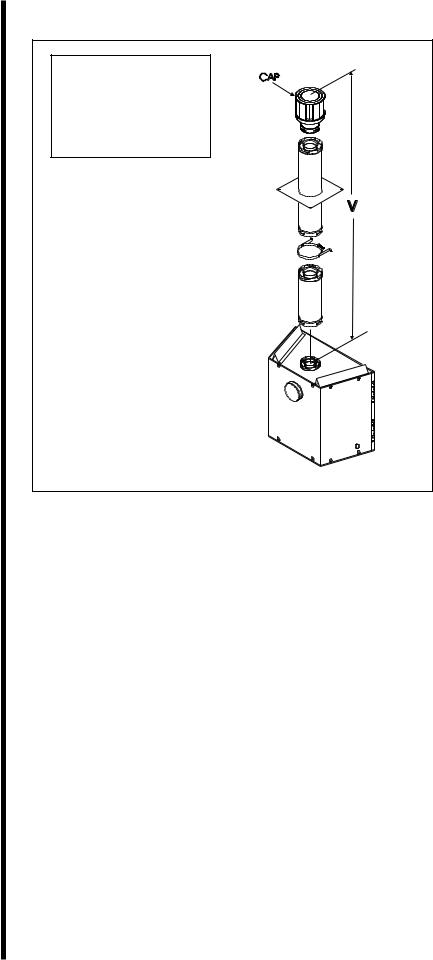
STRAIGHT UP
VERTICAL VENTING
V (FT.)
40' MAX. (12.4 M)
NOTE: Model 6000ARCH
A 12-inch length of straight vent pipe MUST be the first vent component attached to the unit.
Figure 7. Straight Up Vertical Venting
12
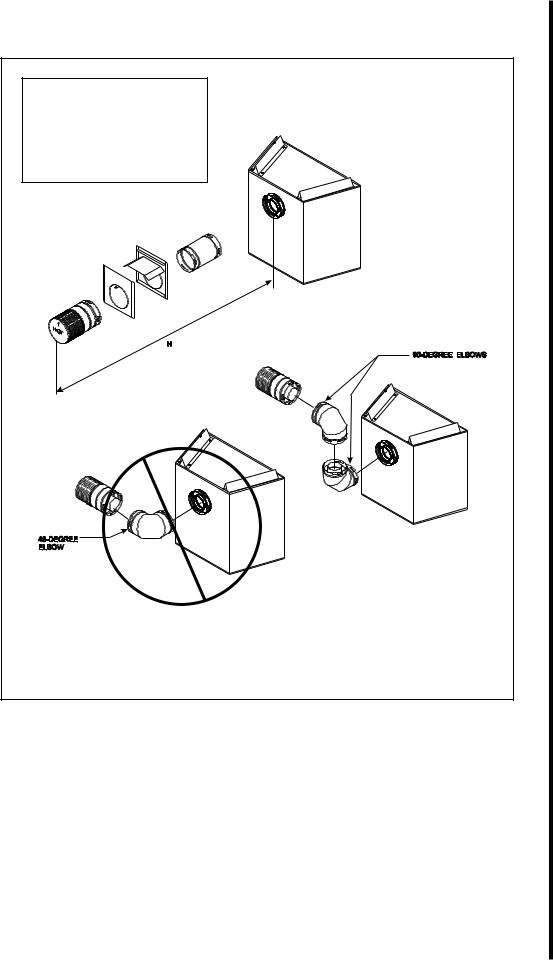
HORIZONTALVENTING
|
H |
Kit No. |
Max. Run |
DVK-01D |
|
DVK-01TRD |
24" (610 mm) |
NOTE: Models 6000TR and 6000XLS are tested and approved to use 45° elbows in corner installations. However, 90° elbows will result in better performance.
Figure 8. Corner Installation
13
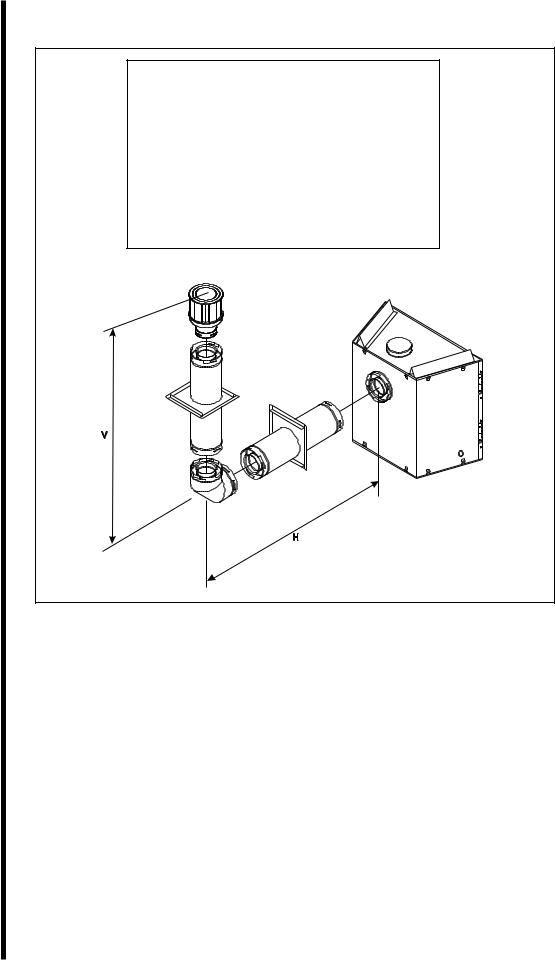
VENTING WITH ONE (1) 90° ELBOW
V (FT.) |
|
H (FT.) |
|
1' MIN. (305mm) |
2' |
MAX. (610mm) |
|
2' MIN. (610mm) |
4' |
MAX. (1.22m) |
|
3' MIN. (914mm) |
6' |
MAX. |
(1.86m) |
4' MIN. (1.22m) |
8' |
MAX. |
(2.4m) |
H = 8' MAX. (2.4m)
V+H = 40' MAX. (12.4m)
Figure 9. Venting with One 90° Elbow
14
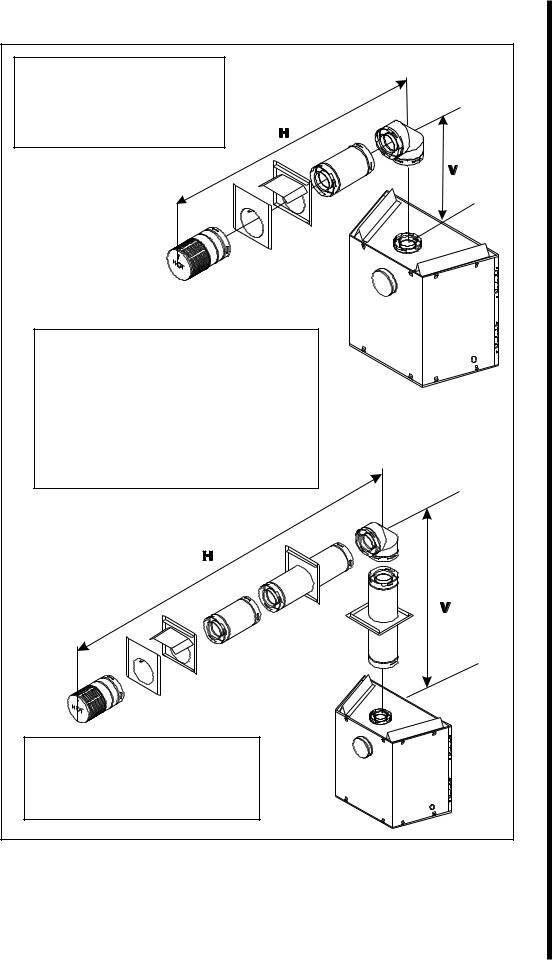
FOR 6000TR & 6000XLT-CDN
NOTE: If a 90o elbow is first attached to the unit, the maximum horizontal run is 3-feet (914mm).
VENTING WITH ONE (1) 90° ELBOW
V (FT.) |
H (FT.) |
1' MIN. (305mm) |
5' MAX. (1.52m) |
2' MIN. (610mm) |
10' MAX. (3.1m) |
3' MIN. (914mm) |
15' MAX. (4.65m) |
4' MIN. (1.22m) |
20' MAX. (6.2m) |
H = 20' MAX. (6.2m)
V + H = 40’ MAX. (12.4mm)
NOTE: MODEL 6000ARCH |
|
A 12-inch length of straight vent |
|
pipe MUST be the first vent |
|
component attached to the unit. |
|
Figure 10. Venting with One 90° Elbow |
|
NOTE: For corner installations: A 6-inch (152mm) MINIMUM length of straight |
|
pipe must be attached to the fireplace before 90o |
elbow. This will allow the vent |
pipe to clear the top standoffs. |
15 |
